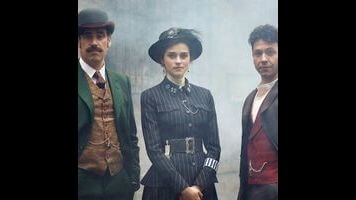The public fallout between Harry Houdini and Sir Arthur Conan Doyle is one of the most dramatically satisfying soured friendships of the 20th century. Conan Doyle, famous for creating the world’s most skeptical detective in Sherlock Holmes, developed a passionate interest in spiritualism in the wake of the First World War. To those who believed, he was the voice of authority; to those with a sense of irony, Conan Doyle had fallen for the sort of nonsense his detective would slap him for. Houdini was one of those who couldn’t believe Conan Doyle had fallen for beyond-the-grave promises; he assured the author repeatedly that, as a magician himself, he recognized the parlor tricks that mediums used. At the height of their public dissonance, Houdini was joining forces with Scientific American magazine to publicly discredit mediums, and Conan Doyle was writing letters to Houdini insisting that such aggressiveness was hardly fair, given Houdini’s own obvious magical powers. You can’t make this stuff up.
Now, the foggy streets of late-Victorian London are the backdrop for the magician and the author to gain access to crime scenes, bicker with each other, and investigate suspiciously supernatural crime. And while Houdini And Doyle is exactly as light as that sounds, and is a little uneven in its early episodes, it also wisely aspires to nothing greater than a good time. But does it have what it takes to get there?
The series has a fortunate anchor in Stephen Mangan, who makes Arthur Conan Doyle a true believer without making him a fool—a tall order, given some of the scientific explanations the show offers up. (His attempts to be a family man are less interesting, but that’s no fault of Mangan’s. When your wife’s in a coma just to give you a reason to seek out mediums, there’s not much you can do.) Houdini is even trickier: Such an over-the-top character requires an actor capable of both great intensity and great insecurity. Michael Weston is not that actor. He’s as abrasive as required, and occasionally seems on the verge of interesting anger (“You’re a doctor! Why would you rather believe she was cured by God than medicine?”), but he’s palpably ill at ease when trying to be the man behind the skeptic. It doesn’t help that the series has halfheartedly thrown the female lead in his way with all the narrative enthusiasm of a seventh-grade slow dance. One hopes Constable Adelaide Stratton (Rebecca Liddiard, offering Rachel-Weisz-in-The-Mummy steeliness), who can sell even defensive exposition about joining Scotland Yard to avoid a life of “pretty dresses and condescension,” gets more to do, quickly.
That’s not an empty hope. The show seems aware the thrill of the chase will always pale next to the characters, and whatever its early faults of execution, its enthusiasm can’t be denied. The cases offer a glimpse at contemporary Victorian grievances and the sort of societal underbelly that still looks good on TV—Magdalene laundries with moody courtyards, faith healers in pristine tents, mediums beside shadowy hearths. (It’s also a slightly more diverse London than period television often provides; Nathan Stewart-Jarrett and Adelayo Adedayo guest star in early episodes.) And occasional bursts of visual energy suggest the show is hoping to at least be stylish comfort food: the long walk through the Yard’s holding cells to Stratton’s basement cubby is more evocative than anyone’s subsequent conversations about her position on the force. The series positively comes to life whenever Houdini’s onstage, with rapid-fire editing working like stage patter to build impressive tension about the welfare of a man we know is going to be just fine. Here, the show has potential to be truly fun. The soundtrack is less confident, awkwardly punctuated with wailing electric guitars and indie-strum hits, but that might just be the post–Knick nature of the beast.
Houdini And Doyle is actually post-quite a lot of things. There’s so much material preceding it that, despite the biographical hook, the show will have to struggle to distinguish itself. (It’s a pilot that has to ask: “Can this live up to the Drunk History sketch?”) In the current cluttered TV climate, a show like this one that might have seemed too far afield a few decades ago, now has more of a chance to find its footing thanks to forerunners like The Knick and Ripper Street, The X-Files and Due South. But Houdini And Doyle isn’t quite there yet. The show will have to find that magic on its own.


 Keep scrolling for more great stories from A.V. Club.
Keep scrolling for more great stories from A.V. Club.